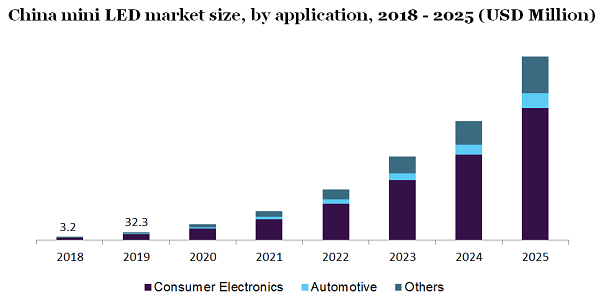- US: +1-408-610-2300
- Toll Free: +1-866-831-4085
- Become a Client
The mini LED market size across the globe was valued at USD 24.6 million in 2018. It is projected to witness significant growth with 86.6% CAGR from 2019 to 2025. This can be attributed to their features like enhanced brightness, more contrast ratio, fast time of response, and lower energy consumption. These features are projected to their demand as compared to the OLEDs (Organic light-emitting diodes).
As redesigning driver ICs is the only process involved in the manufacturing of mini LEDs, several players have started producing them over the conventional LCDs. Also, this process of up-gradation of LCDs is projected to drive the demand for LEDs across the globe, thereby making them competitive over the OLEDs.

LEDs having sizes ranging from 100-200 micrometers are gaining traction across the globe. Also, several players have started developing LEDs sized 50-micrometers. This can be attributed to their rising demand for the production of smartphones, automobile displays, and televisions. Several key players like NationStar, AU Optronics Corp., Harvatek Corporation, and EPISTAR Corporation have also started to showcase their products in electronic shows, exhibitions, and trade shows.
The rising need for improving the thickness and uniformity of wavelength is also contributing to the demand for these LEDs. The adoption of min LED technology is largely found in premium consumer electronic products like high-end televisions and gaming laptops. Moreover, the emergence of V.R. (Virtual Reality) technology is projected to fuel up the demand for mini LEDs in the upcoming years.
In 2018, the application segment of consumer electronics dominated the global mini LED market. This can be associated with the surging need for electronic devices like televisions, laptops, tablets, and smartphones among the millennial population. Also, usage of these mini LEDs in digital displays and backlights is anticipated to fuel up the market growth of this segment.
The automotive segment is also projected to gain traction in the upcoming years. This can be associated with their feature of providing good clarity which will enhance security and safety while driving. A LED-taillight developed by Everlight Electronics Co. Ltd. has been under trial across several automotive companies. It is providing a clear image and is also adhering to all the requirements of the rear light.
In 2018, North America accounted for the largest share across the global market. This can be attributed to the rising presence of automotive and consumer electronics manufacturers and their willingness to invest more in products like mini LEDs. Further, the surging demand for high-end gaming laptops and monitors is projected to fuel up the market growth across this region.
The Asia Pacific is projected to register a significant share in the upcoming years. This can be associated with the rising presence of key players across China, Japan, and Taiwan. Several players located in Taiwan are struggling for manufacturing OLED panels. Moreover, companies across Japan like Japan Display Inc. and Nichia Corporation are engaged in product and technology development.
The market is expected to get positively impacted on account of the COVID-19 crisis. This can be associated with the rising demand for high-end consumer electronic devices owing to the work from home policies being undertaken by several organizations across the globe. Also, the emerging concept of online education is expected to drive the demand for tablets and laptops, thereby creating an opportunity for the adoption of mini LEDs. However, the disruptions in the supply chain due to restrictions over the cargo movement of non-essential food items are anticipated to hinder the market growth. Also, China being one of the major suppliers of the mini LEDs and their spare parts, the market is projected to get impacted greatly during the forecasted years.
The key players in the market are EPISTAR Corporation, Innolux Corporation, Everlight Electronics Co. Ltd., AU Optronics Corp., and Harvatek Corporation. Key manufacturers like EPISTAR Corporation and Lextar are also shipping LED backlights to cater to high-end applications like monitors and gaming notebooks. They are also engaged in product development and innovation to gain a competitive advantage over other players.
They have also started presenting their innovative products in several exhibitions and shows. For instance, a 32-inch monitor with mini-LED backlights was presented by AsusTek Computer Inc. at the Show of NAB in 2019. Also, a mini LED automotive display sized 10.1 inches was exhibited by Innolux Corporation at the CES event in 2018.
|
Attribute |
Details |
|
The base year for estimation |
2018 |
|
Forecast period |
2019 - 2025 |
|
Market representation |
Market revenue in USD Million & CAGR from 2019 to 2025 |
|
Regional Scope |
North America, Europe, Asia Pacific, Latin America, and MEA |
|
Country Scope |
U.S., Canada, Germany, U.K., China, Japan, India, Mexico, and Brazil |
|
Report coverage |
Revenue forecast, Mini LED display volume, company ranking, competitive landscape, growth factors, and trends |
|
15% free customization scope (equivalent to 5 analyst working days) |
If you need specific information, which is not currently within the scope of the report, we will provide it to you as a part of the customization |
This report forecasts revenue growth at the global, regional, and country levels and provides an analysis of the latest industry trends from 2018 to 2025 in each of the sub-segments. For this study, Million Insights has segmented the global mini LED market based on application and region:
• Application Outlook (Revenue, USD Million, 2018 - 2025)
• Consumer Electronics
• Mobile Phones
• Laptop/ Notebooks
• Television
• Automotive
• Others
• Regional Outlook (Revenue, USD Million, 2018 - 2025)
• North America
• U.S.
• Canada
• Europe
• Germany
• U.K.
• the Asia Pacific
• China
• India
• Japan
• Latin America
• Brazil
• Mexico
• MEA


Research Support Specialist, USA